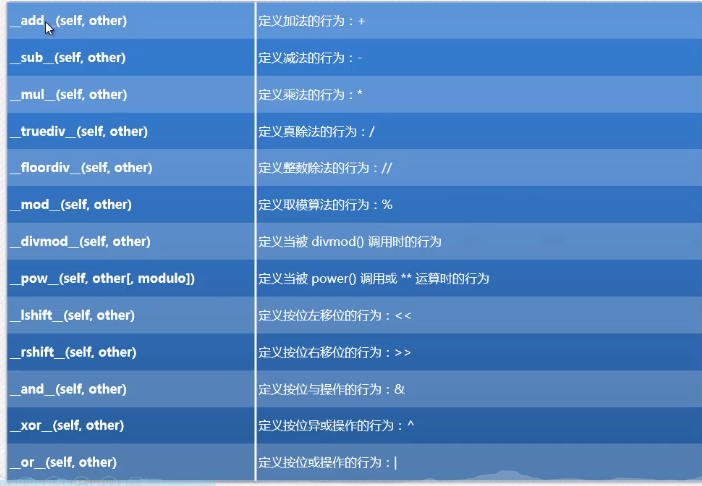课题笔记:
啥是工厂函数?
len()是一个BIF,作用是返回参数的长度。type(len)的话返回 。
。
如果说type(int)则 他是返回一个class “type”。就如同
他是返回一个class “type”。就如同
C定义完了后就是一个类对象。所以所谓的“工厂函数”就是类对象。
int(‘123’),在以前就是调用int函数,将参数转化为123这个整形。而现在不一样了,它是实例化int的这个对象,然后返回一个它示例后的对象。例如:
>>> a = int('123') >>> b = int('456') >>> a +b 579
原来对象是可以进行计算的。
Python的魔法方法还提供了让你自定义对象的数值处理,通过对我们这些魔法方法的一个重写,你可以自定义任何对象间的算术运算。

例子:
>>> class New_int(int): def __add__(self, other): return int.__sub__(self, other) def __sub__(self, other): return int.__add__(self, other) >>> a = New_int(3) >>> b = New_int(5) >>> a + b -2 >>> a - b 8
我这边 可以不return int的魔法方法吗?
>>> class Try_int(int): def __add__(self, other): return self + other def __sub__(self, other): return self - other >>> a = Try_int(3) >>> b = Try_int(5) >>> a + b Traceback (most recent call last): File "<pyshell#34>", line 1, in <module> a + b File "<pyshell#31>", line 3, in __add__ return self + other File "<pyshell#31>", line 3, in __add__ return self + other File "<pyshell#31>", line 3, in __add__ return self + other [Previous line repeated 1022 more times] RecursionError: maximum recursion depth exceeded >>>
结果出现了无限递归!去到了递归的最高层次就出来了,自动退出了。为什么会这样子呢?
当a+b的时候出现加法,自动先调用前者a的一个add,先调用一个add 的一个魔法方法;那调用add 的话返回的是什么?返回的是self加上other,self是示例对象绑定的一个方式(绑定进来的方式),那么这个self就是绑定了这个a进来,other就是加法右边的数(也就是b);那return的又是a+b,这样就出现无限递归。
后面会讲到关于属性的魔法方法,更要注意这些情况了。
可以这样改:
>>> class Try_int(int): def __add__(self, other): return int(self) + int(other) #也可以不用int这个other def __sub__(self, other): return int(self) - int(other) >>> a = Try_int(3) >>> b = Try_int(5) >>> a + b 8 >>>
测试题:
0. 自 Python2.2 以后,对类和类型进行了统一,做法就是将 int()、float()、str()、list()、tuple() 这些 BIF 转换为工厂函数。请问所谓的工厂函数,其实是什么原理?
工厂函数就是将参数实例化成对象,然后调用其中的魔法方法
答:工厂函数,其实就是一个类对象。当你调用他们的时候,事实上就是创建一个相应的实例对象。
# a 和 b 是工厂函数(类对象) int 的实例对象 >>> a = int('123') >>> b = int('345') >>> a + b 468
1. 当实例对象进行加法操作时,会自动调用什么魔法方法?
自动调用__add__(self, other)
答:对象 a 和 b 相加时(a + b),Python 会自动根据对象 a 的 __add__ 魔法方法进行加法操作。
2. 下边代码有问题吗?(运行起来似乎没出错的说^_^)
class Foo: def foo(self): self.foo = "I love FishC.com!" return self.foo >>> foo = Foo() >>> foo.foo() 'I love FishC.com!'
foo是Foo示例化的一个对象,foo.foo()就是调用Foo类里面的foo这个函数? self就是foo, self.foo就是对象foo的foo属性等于一串字符串,foo函数最后返回这个属性
答:这绝对是一个温柔的陷阱,这种BUG比较难以排查,所以一定要注意:类的属性名和方法名绝对不能相同!如果代码这么写,就会有一个难以排查的BUG出现了:
class Foo: def __init__(self): self.foo = "I love FishC.com!" def foo(self): return self.foo >>> foo = Foo() >>> foo.foo() Traceback (most recent call last): File "<pyshell#21>", line 1, in <module> foo.foo() TypeError: 'str' object is not callable
3. 写出下列算术运算符对应的魔法方法:
|
运算符
|
对应的魔法方法
|
|
+
|
__add__(self, other) |
|
-
|
__sub__(self, other) |
|
*
|
__mul__(self, other) |
|
/
|
__truediv__(self, other) |
|
//
|
__floordiv__(self, other) |
|
%
|
__mod__(self, other) |
|
divmod(a, b)
|
__divmod__(self, other) |
|
**
|
__pow__(self, other[,modulo]) |
|
<<
|
__lshift__(self, other) |
|
>>
|
__rshift__(self, other) |
|
&
|
__and___(self, other) |
|
^
|
__xor___(self, other) |
|
|
|
__or___(self, other) |
4. 以下代码说明 Python 支持什么风格?
def calc(a, b, c): return (a + b) * c >>> a = calc(1, 2, 3) >>> b = calc([1, 2, 3], [4, 5, 6], 2) >>> c = calc('love', 'FishC', 3) >>> print(a) 9 >>> print(b) [1, 2, 3, 4, 5, 6, 1, 2, 3, 4, 5, 6] >>> print(c) loveFishCloveFishCloveFishC
对象间可以进行相加
答:说明 Python 支持鸭子类型(duck typing)风格。详见:【扩展阅读】鸭子类型(duck typing)
动动手:
0. 我们都知道在 Python 中,两个字符串相加会自动拼接字符串,但遗憾的是两个字符串相减却抛出异常。因此,现在我们要求定义一个 Nstr 类,支持字符串的相减操作:A – B,从 A 中去除所有 B 的子字符串。
示例:
>>> a = Nstr('I love FishC.com!iiiiiiii') >>> b = Nstr('i') >>> a - b 'I love FshC.com!'
自己写的:
class Nstr(str): def __sub__(self, other): return str.split(self,other)
答案:
class Nstr(str): def __sub__(self, other): return self.replace(other, '')
1. 移位操作符是应用于二进制操作数的,现在需要你定义一个新的类 Nstr,也支持移位操作符的运算:
>>> a = Nstr('I love FishC.com!') >>> a << 3 'ove FishC.com!I l' >>> a >> 3 'om!I love FishC.c'
答:只需要重载 __lshift__ 和 __rshift__ 魔法方法即可。
class Nstr(str): def __lshift__(self, other): return self[other:] + self[:other] def __rshift__(self, other): return self[-other:] + self[:-other]
2. 定义一个类 Nstr,当该类的实例对象间发生的加、减、乘、除运算时,将该对象的所有字符串的 ASCII 码之和进行计算:
>>> a = Nstr('FishC') >>> b = Nstr('love') >>> a + b 899 >>> a - b 23 >>> a * b 201918 >>> a / b 1.052511415525114 >>> a // b 1
代码清单:
class Nstr: def __init__(self, arg=''): if isinstance(arg, str): self.total = 0 for each in arg: self.total += ord(each) else: print("参数错误!") def __add__(self, other): return self.total + other.total def __sub__(self, other): return self.total - other.total def __mul__(self, other): return self.total * other.total def __truediv__(self, other): return self.total / other.total def __floordiv__(self, other): return self.total // other.total
也可以这样写:
class Nstr(int): def __new__(cls, arg=0): if isinstance(arg, str): total = 0 for each in arg: total += ord(each) arg = total return int.__new__(cls, arg)
第二种方法是用了继承了int 的属性,利用new在之前就把字符串先转成了ASCII码,然后用int的属性,int类型是有加减乘除这些的。